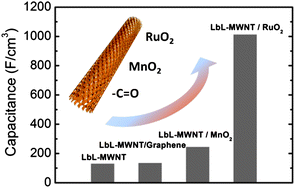Nanostructured carbon-based electrodes: bridging the gap between thin-film lithium-ion batteries and electrochemical capacitors
Abstract
The fast evolution of portable electronic devices and micro-electro-mechanical systems (MEMS) requires multi-functional microscale energy sources that have high power, high energy, long cycle life, and the adaptability to various substrates. Nanostructured thin-film lithium-ion batteries and electrochemical capacitors (ECs) are among the most promising energy storage devices that can meet these demands. This perspective presents an overview of recent progresses and challenges associated with the development of binder-free, carbon-based nanostructured electrodes prepared from layer-by-layer (


 Please wait while we load your content...
Please wait while we load your content...